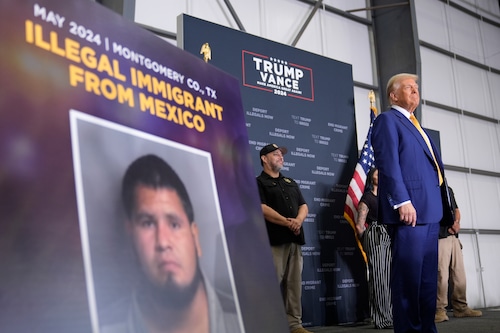Before we inquire about Donald Trump’s ability to deport millions, keep this in mind: Barack Obama has already demonstrated how. Without the assistance of the military, his government deported 3 million individuals using only buses, U.S. Immigration and Customs Enforcement (ICE) officials, and a merciless efficiency that won him the title of Deporter-in-Chief. Five American children were left behind when parents like Andres Jimenez were detained for driving without a license. Deportations were lower during Trump’s first term, but he is now vowing to increase military might.
Former President Donald Trump’s prior emphasis on internal deportations and his executive order and signature limiting immigration from a number of Muslim-majority nations contrast with the Biden administration’s border-centric strategy. Trump’s immigration legacy is different from that of the interior of the United States because of his intense focus on erecting a wall along the southern border and enforcing a Muslim ban that prohibited entry into the nation from six nations with a majority of Muslims. According to CNN, Trump deported 1.5 million individuals during his first term as president, which is a small portion of Obama’s immigration record. However, it appears that the president-elect is eager to make a greater influence on immigration in the United States this time around, based on his previous comments.
According to Silky Shah, executive director of Detention Watch Network, he is doing everything he can to blame immigrants for the issue.
Trump indicates a more aggressive approach to immigration by using rhetoric on the campaign trail that targets immigrant and migrant populations, appointing former ICE director Tom Homanas as border czar, and declaring his intention to utilize the military. The facilities of ICE are already being expanded. According to a September report by Detention Watch Network, ICE has stated plans to expand in 15 states, and the planned detention centers that are set to open in New Jersey next year will have 600 beds.
Advocates claim that increasing ICE facilities is inhumane and ineffectual as the strategy for mass deportations becomes more solidified.
If implemented, ICE’s expansion plan will further exacerbate the abusive detention system by increasing the targeting and racial profiling of individuals in their communities based on their appearance, language, and place of employment. The head of organizing and membership for Detention Watch Networks, Marcela Hernandez, stated.
The deportation infrastructure is already in place
Shah claims that after the Bush administration’s 2008 raid at a meat processing facility in Iowa, where 389 migrant workers were detained, the Obama administration shifted away from conducting large-scale raids. Through initiatives like Secure Communities, Obama expedited cooperation between the Department of Homeland Security, the Federal Bureau of Investigation, and local law enforcement, resulting in more than 750,000 deportations prior to its end in 2014.
According to Shah, deportations increased under Bush and continued to rise after the Obama administration improved the system’s ability to target individuals and those who had dealt with the criminal justice system.
According to the National Immigrant Justice Center, the United States spends more than $3 billion annually on the detention process, which often involves holding a detained individual in a detention facility before they are tried or deported abroad.
In July 2024, ICE housed 37,509 inmates in its more than 200 detention facilities, jails, and prisons across the United States. According to some accounts, these overcrowded, underfunded facilities are barbarous. The alarming circumstances are described in reports from the Office for Civil Rights and Civil Liberties of the Department of Homeland Security.
NPR claims that reports from 2017 to 2019 show filthy and dangerous conditions, abuse of mentally ill inmates, and a lack of medical attention, including fabricated records claiming that a detainee who asked for an inhaler was seen by medical staff when he wasn’t. The realities of life under ICE’s supervision are made clear by first-hand reports.
Ana Navarro, a former detainee who entered the country illegally and experienced domestic abuse, spoke of mistreatment in the Dodge County Jail in Wisconsin. She claims that there were no Spanish interpreters on duty and that the inmates were kept in their cells all day long, only being able to out for meals.
Imagine being chilly and experiencing mental health issues while spending your days cooped up in a small space with no access to hygienic food or sanitation. Because there was nothing to do, it was worse than prison. According to Navarrow’s February article in South Side Weekly, there were no diversions for the populace, no fresh air, and more humiliations.
Immigrant detention is governed by the Department of Homeland Security (which includes ICE and U.S. Customs and Border Protection), the Department of Health and Human Services, and the Department of Justice, with state-specific protocols.
In hostile immigration environments, such as Texas, complex networks of agents patrol not only the U.S.-Mexico border but also the state’s numerous checkpoints, where inhabitants are questioned about their legal status. Hospitals that accept Medicaid or CHIP coverage are now required by an executive order signed by Governor Greg Abbott to inquire about patients’ status, making ER trips potentially problematic.
People will be terrified right now because they will be asked about their immigration status, which was already a source of anxiety. “This is an executive order, so now they’re going to be asked about their immigration status,” Zaena Zamora, executive director of Frontera Fund, an abortion fund that serves people within 100 miles of the Texas-Mexico border, told Reckon in August. “A lot of people don’t like to go to doctors or official places like that because they’re afraid of being asked about their immigration status.”
ICE provided funds for 41,500 beds in fiscal year (FY) 2024, which was the third-highest amount ever authorized by Congress.According to the American Immigration Council, ICE may imprison more people by taking funds from other sources, as was the case in FY 2019, when over 55,000 people were detained despite a 40,520 budget from Congress.
However, Shah argues it’s crucial to stop Trump from getting funding.
“I think it’s going to be really important to do everything we can to get the Democrats to hold the line and not allow the scales of money he’s asking for,” she said, adding that he would need billions of dollars in more funding to carry this out.
How a second Trump administration can enforce the military for immigration
Trump appointed his former ICE director, Tom Homan, as border czar last week. In this role, he will be in charge of deportation, maritime security, and U.S. borders.According to the Associated Press, Trump has openly stated his intention to conduct the largest deportation campaign in American history.
Nobody is leaving the table. “You better be watching your back if you’re here illegally,” Homan stated at the July National Conservatism Conference.
Although specifics are yet unknown, Trump declared his intention to use the military and declare a national emergency.
According to legal experts, Trump might employ the military in accordance with the 1792 Insurrection Act, which gives the president the authority to utilize the armed forces domestically to quell civil disorder. The statute was last put into effect during the 1992 L.A. Riots, when troops were sent in by President George H.W. Bush.
Trump may justify his assault on Mexican cartels and human trafficking by presenting a picture of criminals crossing the southern border, according to a Vox analysis.
Military deployment may be lawful, but the obstacles to obtaining congressional backing and locating the capacity to jail more people point to fear-mongering, according to Alissa Cooley Yonesawa, managing attorney at the UNLV Immigration Clinic in Las Vegas.
“I don’t think they have the infrastructure, the manpower, and the organization to get that done,” she said, adding that she didn’t think it would happen in the first few years of the administration.
Following the election, Trump’s desire to abolish birthright citizenship sparked discussion on social media.
You can’t expect that to happen overnight. According to Cooley Yonesawa, “that’s not an executive order where he can just sign a piece of paper and it’s done, I mean, that’s in the Constitution.” Therefore, we believe that anything on social media concerning birthright citizenship is typically going to be a diversion from the more likely and frightening events by inciting political dread and scare-mongering. It resembles a glance over there.
She is more worried about the growth of expedited removal, which allows non-citizens to be deported without a hearing and may relieve some of the strain on the immigration courts, which currently have three million cases pending.
An ICE officer may stop you or me on the street and ask to verify that I have been in the United States for two years, she added, because the expansion of Expedited Removal involves extending border policy into our neighborhoods, away from the border.
Regarding military engagement, Shah is worried about the possibility that military bases could turn into prison facilities.
They all already live in appalling conditions, but I believe there is some worry because, you know, they need a place to hold people before they can deport them, Shah added.
More on Obama and what that means/Trump building on the Deporter-in-Chief legacy
By creating the Deferred Action for Childhood Arrivals program (DACA), which protected over 800,000 DREAMers—children brought to the United States as children—from deportation, Obama softened his position on undocumented kids and acquired the moniker “Deporter-in-Chief.” Politicians still use the damaging myths Obama promoted, which depict immigrants as criminals.
Obama, according to Shah, contributed to the development of the good vs. evil immigration narrative by portraying some immigrants as criminals and others as families seeking the American Dream.
In a contentious 2014 address on immigration, Obama stated, “We’re going to keep focusing enforcement resources on actual threats to our security because deportations of criminals have increased by 80% over the past six years.”Families are not felons. Not kids, but criminals. Gang members, not hard-working mothers trying to support their children.
The human and economic toll of mass deportation
Jimenez’s wife, Luca Quiej, and their five children suffer both financially and emotionally as a result of their father’s deportation after he was arrested for driving without a license.
According to the National Institute of Health,Even Americans who know someone who has been arrested or deported are more likely to suffer from psychological discomfort, anxiety, and despair.
Deportations have an impact on entire communities in addition to individual families. Even Americans who know someone who has been deported or jailed had higher rates of psychological distress, anxiety, and depression, according to the National Institutes of Health. These effects on mental health exacerbate already-existing financial difficulties.
When wage-earning parents are deported, the surviving families in communities with high deportation rates frequently experience an immediate financial crisis, which increases their dependency on social services and local support systems. There are long-term educational and financial repercussions when kids drop out of school to work and provide for their families.
The effects on the economy extend well beyond immigrant neighborhoods. Mass deportations will result in severe labor shortages across important American industries, as Wharton School economics professor Zeke Hernandez wrote in The Guardian. Particularly heavily hit would be the construction, service, and food processing industries, as well as agriculture, where an estimated 50% of the labor is illegal. All Americans may be impacted by price rises and supply chain disruptions brought on by these labor shortages.
According to Hernandez, it would be a financial catastrophe for Americans and America. Not only would immigrants suffer, but so would the American people from an economic standpoint.
Note: Every piece of content is rigorously reviewed by our team of experienced writers and editors to ensure its accuracy. Our writers use credible sources and adhere to strict fact-checking protocols to verify all claims and data before publication. If an error is identified, we promptly correct it and strive for transparency in all updates, feel free to reach out to us via email. We appreciate your trust and support!







+ There are no comments
Add yours